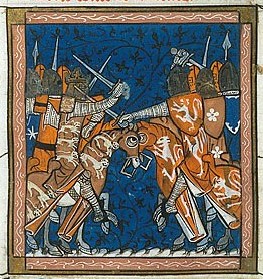Battle of Lewes
Coordinates: 50 ° 52 ′ 43 ″ N , 0 ° 0 ′ 50 ″ W.
| date | May 14, 1264 |
|---|---|
| place | Lewes / East Sussex |
| output | Victory of the Barons |
| Parties to the conflict | |
|---|---|
|
royal troops |
English barons |
| Commander | |
|
|
|
| Troop strength | |
| unknown | unknown |
| losses | |
|
Capture of King Henry III. and Lord Eduards |
|
The Battle of Lewes took place in Lewes , England on May 14, 1264 . It represented the climax of the first phase of the Second War of the Barons . The victory of the aristocratic opposition around Simon de Montfort, 6th Earl of Leicester over the troops of King Henry III. brought government power to the aristocratic opposition.
prehistory
Since 1258, the English King Henry III. Fight against a nobility opposition whose leader was his brother-in-law Simon de Montfort. In the Provisions of Oxford in 1258, the barons succeeded in transferring substantial parts of government power to a 15-member council. This Council should be monitored by the Parliament, which should meet three times a year. Henry III. tried in the next few years to end this restriction of his sovereignty again. In order to settle this resulting conflict between the aristocratic opposition and the king, the French King Louis IX was founded in 1263 . called. This declared in January 1264 in his arbitration award, the Mise of Amiens , the Provisions of Oxford null and void.
This left the barons only with the recognition of royal sovereignty or armed rebellion. The aristocratic opposition under Simon de Montfort had gathered an army in London, whereupon Henry III. the city blocked. Simon de Montfort then left London and moved south with his army. The king then reached Lewes Monastery on May 11, 1264 , where he took up quarters, while his son, Lord Edward, who later became King Edward I , occupied Lewes Castle . On May 12, Montfort reached Lewes and offered negotiations. The king initially wanted to agree, but was changed by his brother Richard of Cornwall and Lord Edward, who refused to compromise. The king, Lord Eduard and Richard of Cornwall declared Montfort and his ally Gilbert de Clare to be enemies of the king, whereupon Montfort and Clare formally renounced their allegiance to the king through diffidatio . On May 14th, a battle broke out between the rebel army and the king's troops, who outnumbered their opponents twice.
The battle
Montfort's troops, wearing white crosses as badges, had lined up in a broad front on a hill west of Lewes. The king had his army attacked in three columns. The attack by Lord Edward crushed the lightly armed and armored infantry from London, but carelessly pursued the retreating opponents. His undisciplined attack left Richard of Cornwall in the center and the King on the left, open to Montfort's attacks. The king lost control of his army and was often struck by lances and swords in intense fighting. Richard of Cornwall escaped from the battlefield and hid in a windmill. After the king lost the horse for the second time, his bodyguard brought him back to the monastery of Lewes. When Lord Edward turned back, the battle was decided, part of his column fled towards the coast, while he himself also withdrew to the monastery. With this, Montfort's troops had defeated the royal army within a few hours.
consequences
The King and Lord Eduard forego any further resistance and accepted Montfort's Mise of Lewes the following day . The king then recognized the commission again, with Montfort allowing him to renegotiate on disputed points. The barons, especially the Marcher Lords , who had supported the king, were released while the king surrendered to Gilbert de Clare. Lord Eduard and Henry of Almain , a son of Richard of Cornwall, were also captured and served as hostages to the retinue of the Marcher Lords. Montfort now took over the government, but his abundance of power aroused new resistance. Lord Eduard was finally able to flee in May 1265 and in August decisively beat the troops of the aristocratic opposition in the Battle of Evesham , in which Montfort fell.
literature
- JR Maddicott: Simon de Montfort (Cambridge University Press, 1996)
- Mandell Creighton: Life of Simon de Montfort, Earl of Leicester (Adamant Media Corporation, 2001)
- John Sadler: Second Baron's War: Simon de Montfort and the Battles of Lewes and Evesham (Pen and Sword, 2009)
- HW Ridgeway: Henry III (1207-1272). In: Henry Colin Gray Matthew, Brian Harrison (Eds.): Oxford Dictionary of National Biography , from the earliest times to the year 2000 (ODNB). Oxford University Press, Oxford 2004, ISBN 0-19-861411-X , ( oxforddnb.com license required ), as of 2004
